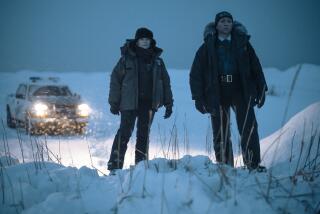Op-Ed: The reality is there’s plenty of fake TV shows in Alaska

Is this mortifying era of northern overexposure ever going to end?
Here in Alaska, TV crews have been everywhere the last few years, clutching scripts for “unscripted” shows and handing out confidentiality agreements, asking us to play along. A friend in my hometown who runs a cute bakery by the beach turned down six different producers in the last year. Not everyone is so selective. Several dozen of these “reality” shows have made it to cable — most of them populated by nutty eccentrics and paid for with state subsidies.
Out near my cabin in the remote Wrangell Mountains last summer, a friend and I counted four shows being filmed within a 60-mile radius of our conversation. As we spoke, a truck pulled up in front of his gift shop bearing the logo for a fifth one: “Slednecks,” an MTV production about booze-fueled hijinks in former Gov. Sarah Palin’s hometown of Wasilla.
I get why it’s popular: Uncouth behavior and flimflam have been part of the American frontier narrative since Davy Crockett’s day. We Alaskans are happy to see our friends make easy money playing characters based on themselves. For example, the droll stage presence and lifelong improvisational habits of my neighbors, the Kilchers, come off well in “Alaska: The Last Frontier.” But why must the narrator pretend they are locked in some desperate struggle to survive, without ever mentioning the three supermarkets in town, to say nothing of that nice locavore bakery by the beach?
So much is exaggerated or flat made up. We see acquaintances exclaim about the indoor plumbing as they shop for houses that we know aren’t really for sale. We watch them cry out in mock alarm as they fall into icy rivers with dry suits hidden under their Carhartts. Bristol Bay fishermen formally protest errors on Animal Planet’s “Battle on the Bay.” Eskimos object to their portrayal on TLC’s “Escaping Alaska.”
Nervous perhaps about dabbling in such a veracity-challenged business, the Alaska State Troopers finally pulled the plug on their eponymous series. The move came not long after a defense lawyer suggested that his client had been singled out for an investigation of hunting violations because his “Wild West Alaska” show aired on Animal Planet and the troopers’ show was on National Geographic Channel.
What’s strange is that this cringe-worthy montage has been subsidized by the state of Alaska. One-third or more of a production’s costs can be refunded through a film incentive program launched under Palin in 2008. The idea was to attract feature films, create local jobs and publicize the state’s charms. But there was a backlash — some legislators didn’t like it when actor Ted Danson showed up on a film set to lecture them on the environment, while others complained about $360,000 paid to support Bristol Palin’s short-lived show about being a single mom. The state responded by making everything confidential, so we don’t even know how much this is costing. The state paid out $44 million up to 2013, and probably at least that much more since then. Officials say the majority has gone to TV, with 29 unscripted programs applying for subsidies last year.
The low point came last fall when cast members in “Alaskan Bush People” were charged in court with fraud. The defendants were known to TV viewers as a long-haired family of nine “discovered” by the Discovery Channel living so far from civilization that they would “go six to nine months of the year without seeing an outsider,” according to the series’ website. Season one ended with the family abandoning an unfinished cabin, fleeing gunshots in green-lighted night scenes. Reporters asked questions. No vigilante gunfire had been reported to state troopers, but a fed-up neighbor in the rural subdivision passing for deep wilderness did admit he launched fireworks to scare off the helicopter dangling a Cineflex camera system over his backyard.
There’s nothing illegal, of course, about making things up and calling it reality on television. If there were, Alaska’s courts would be jammed with complaints about staged “accidents,” grizzly bears filmed in game parks and Safeway supermarkets airbrushed from the survivalist landscape.
The Alaskan Bush People, however, were accused of submitting fraudulent applications for Permanent Fund dividends, the oil-money checks that go to state residents every year. According to prosecutors, the “Alaskan Bush People” faked even being full-time Alaskans.
The lesson: Say what you want about us, but don’t mess with our oil money.
At least the dip in global oil prices may rescue our reputation. Alaska’s newly elected independent governor, Bill Walker, says plummeting tax revenues will probably mean shutting down the state film subsidies. Like so much else in the non-fantasy state of Alaska, the public humiliation of our crab fishermen, gold miners and hippie homesteaders seems unlikely to survive the loss of government underwriting.
Tom Kizzia is the author of “Pilgrim’s Wilderness: A True Story of Faith and Madness on the Alaska Frontier.”
Follow the Opinion section on Twitter @latimesopinion and Facebook
More to Read
A cure for the common opinion
Get thought-provoking perspectives with our weekly newsletter.
You may occasionally receive promotional content from the Los Angeles Times.






